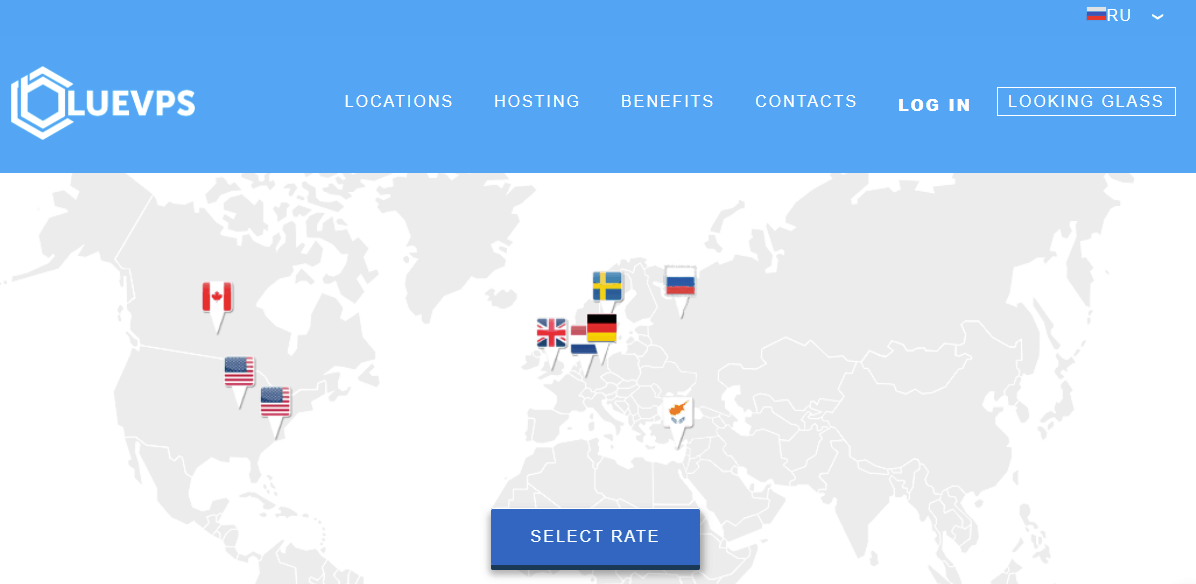BlueVPS, just like its name suggests, offers virtual private server services.
These plans are ideal for websites that have a lot of traffic or those who need more resources than a shared server, but don’t have the funds to hire dedicated servers.
BlueVPS has data centers in ten countries and can reach clients from different regions of Europe. Its website can be accessed in English and Russian.
Features and Ease-of-Use
BlueVPS.com offers Windows and Linux plans. It also offers VPS plans for both Windows and Linux. On the Linux platform, there are special VPS plans. It offers 28 plans total on its VPS platform. These plans offer the following features:
- 99.9% uptime guarantee
- Disk space available from 7GB to 2TB
- Unlimited bandwidth from 5TB to unlimited
Its plans can be hosted on either Windows or Linux, as mentioned earlier. Depending on the type of applications that a client wants to run, the operating system they choose will affect which platform they use. Most control panels, software, and modules can be run on Linux. However, some applications, such as MSSQL and ASP.NET, cannot be used on Windows servers.
BlueVPS uses KVM virtualization, which allows it to function exactly like a dedicated server. You can also access the kernel directly and customize the system to meet your specific needs.
You can choose from a range of free and paid control panels, including cPanel and ISPmanager, VestaCP, and VirtualMin. These control panels can be used to access all aspects of your hosting account. It supports all major CMS such as WordPress, Drupal, and Magento. It supports frameworks such as Node JS and JQuery, Zend, or Django.
BlueVPS provides remote access to virtual network computing (VNC), which allows you to manage your account from anywhere.
The HD-KVM and bKVM plans include RAID 10 hard drives (HDD), while SSD-KVM has solid-state drives (SSD). These plans also include SSD caching, which increases the processing speed for regularly loaded content.
BlueVPS Review – Pricing and Features
So there are many VPS choices. You can choose from 8 different VPS plans right on the homepage.
$2/month for the ‘KVM 256’ plan. 2.66GHz is a fast connection, with 256 MB RAM, 10GB HDD, 1Gbps speed, unlimited bandwidth, IPv4 and IPv6 access, SSH & VNC, unlimited bandwidth, KVM virtualization, and 256 MB RAM.
What’s KVM virtualization?
KVM stands to Kernal-based Virtual Machine. It is a Linux host capable of running virtual environments that can be used with any OS.
You can likely run an older version of OS such as WindowsXP, FreeBSD, or any other minimal Linux distribution with the above specifications. Security is less important because you can easily get customized measures or programs that will protect your site.
Most plans include minor upgrades to bKVM256 such as RAM, storage, and processor count.
The plan ‘bKVM1024’ has dual 2.66GHz processors (not cores, but individual processing units), 1GB memory, and 20GB storage for $6/month. Our opinion is that this plan offers value for money.
The plan KVM-8192 offers four 2.66GHz processors, 8GB RAM, and 200GB storage. It costs $34 per month, which is quite expensive.
This plan will allow you to run more heavy stuff, such as a Windows 10 environment (4GB of memory is the limit), a shared data hub for your startup, possibly your own gaming server, and many other things.
The pricing of plans is affordable and offers rare features. The pricing is for an annual billing cycle. You can choose to alternate between biennially, monthly, quarterly, semi-annually, and biennially.
BlueVPS Review: Pros and Cons
BlueVPS offers VPS services using data centers located in ten countries around the globe. You can choose from two operating systems or five control panels. These plans allow for the automatic installation of applications. These plans also offer a wide range of options at affordable prices.
Pros
- Plans work on Linux OS and Windows OS.
- Selectable control panels available
- Servers for SSD and HDD with RAID 10
- Automated installation of applications
Cons
- The hosting provider does not offer shared plans
- There are no self-support channels

